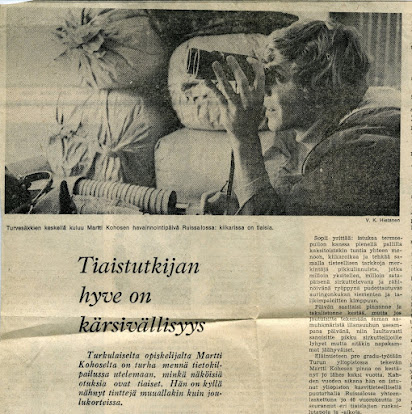I remember sitting at the kitchen table with my father a couple of years ago, looking out over the snow-covered yard. There was a rustle in the old rowan tree: Once again, I was amazed at the number of tits at my parents' bird feeder. Great tits, Eurasian blue tits, willow tits, coal tits.
- Hey, is that a coal tit, I asked Dad, who had done his Master's thesis on tits at the University of Turku in the late 1970's. His research project included hours of winter-time observation, with binoculars, no tech assisted business back then, at the bird feeder of the Ruissalo research station. He continued his observation routine over three winters. Three winters! Who would do such research nowadays!
Dad hardly looked at the bird feeder and said, "Yes, it’s a coal tit".
- How can you tell that, you barely turned your head, and you don't even have your glasses on, haha, I challenged the interpretation.
- It’s in their appearance, their essence, said Dad and turned to his coffee mug, his shoulders slightly hunched.
I stared at the flock of tits moving from the rowan branches to the bird feeder and back, moving in the rhythm of their feeding. It was like the motion of a heart: their flight pattern drawing the widening and contracting of the heart, each in turn snatching a sunflower seed from the feeder and flying back to the branches of the old rowan tree.
- Oh, its essence...
Dad had started his own birdwatching hobby in his early teens. In their large flock of siblings, his older brother was an enthusiastic observer of nature. During his career as a biology and geography teacher, Dad also set up nature clubs in the secondary schools and upper secondary schools where he worked. Certainly, over the years, each species had become so familiar that he only had to glance in the given direction, and he could immediately tell which bird it was.
- When was the last time you saw a crested tit, I continued. Dad looked out into the yard.
- It's been years, he replied.
Dad died unexpectedly early November. In this very kitchen. Dad's heart had run its course.
I sit at the same kitchen table and look again at the birds that I now feed in my Dad’s place.
A pair of crested tits surprised me early December. They appeared with a mixed winter flock of tits at the bird feeder, for the first time in decades. So there is hope for this endangered bird. Staring at it in amazement, it indeed did seem to have its own essence: Somehow bold, straightforward.
"Birds are not just descended from dinosaurs, they are dinosaurs," wrote Helsingin Sanomat, a Finnish newspaper, in 2018. "Birds are descended from theropods, a group of dinosaurs which included the ferocious Tyrannosaurus Rex and the feathered Deinonychus, which preyed in the flock."
When you consider the essence of an object, it's as if you're looking beyond the surface at something that the physical eye can't necessarily reach. This inner seeing is also called contemplation. I can almost see in the corner of my eye, within that crested tit, a kind of a tuft-headed flying dinosaur. There it is, at the bird feeder, nibbling on sunflower seeds.
One of the things I learned from my Dad is this human ability to combine facts with humour, resulting in hilarious mental associations. Sometimes humorous mental images open new doors in our own thinking, not to mention in the way we work and develop our work, thus enabling revolutionary innovations.
I wish all of us working in the field of learning and teaching a semester in which we give ourselves the opportunity and time to pause, to wonder, to reflect, to practise inner seeing of things - and to allow ourselves new, even funny-seeming associations. With restfulness, such pausing is essential for personal well-being, well-being at work, reflection, and all the development efforts we will engage in this semester.

Comments
Post a Comment